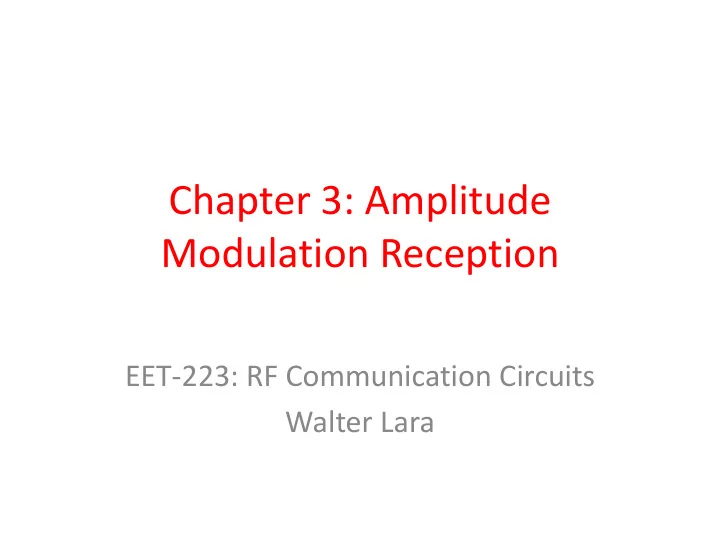

Chapter 3: Amplitude Modulation Reception EET-223: RF Communication Circuits Walter Lara
Tuned Radio Frequency (TRF) Receivers • Simplest/Oldest AM receiver (see Fig 3-1) • Consists of: – RF Amplifier: • Amplifies weak signal from antenna • Low noise characteristics • Tuned to carrier and sideband frequencies – Detector: extracts the intelligence from the AM signal – Audio Amplifier: provides sufficient power to drive loudspeaker
Figure 3-1 Simple radio receiver block diagram.
Receiver Characteristics • Sensitivity: minimum input signal (voltage) required to produce a specified output signal – The lower, the better – Must be greater than noise floor (input noise) – Range from mV (cheap ) to µV (expensive) • Selectivity: extend to which a receiver can differentiate between desired signal and other undesired signals or noise – Optimum value equals bandwidth needed for carrier and sidebands (e.g., for AM, 30-KHz) – TRF receivers suffer from variable-selectivity problem (because of tuned circuits)
AM Detection (Demodulation) • Non-linear device (e.g., BJT or Op Amp) used for detection which results on components at: – Carrier frequency (f c ) – Lower-side frequency (f c - f i ) – Upper-side frequency (f c + f i ) – DC Component – Intelligence frequency (f i ) • LPF used to suppress RF components leaving only intelligence and DC components
Figure 3-2 Nonlinear device used as a detector.
Diode Detector • Simple and effective • Nearly perfect nonlinear resistance characteristic • Advantages: – Can handle high power – Acceptable distortion levels – Highly efficient (~90% achievable) – Support Automatic Gain Control (AGC) circuits • Disadvantages: – Tuned circuit power absorbed by diode (reduces selectivity) – Doesn’t provide amplification
Figure 3-3 Diode detector.
Superheterodyne Receivers • Developed in the early 1930, still dominant • Advantages: – Constant selectivity over wide range of received frequencies (unlike TRF’s) – Better sensitivity – Lower distortion (better linearity) – Provide amplification • Disadvantages: – More complex, costly – Image frequency problem (more later) • Block Diagram shown at Fig 3-6 (see next side)
Figure 3-6 Superheterodyne receiver block diagram.
Superheterodyne Receiver Components • Main components are: – RF Amplifier: pre-amplifies RF signal (if required) – Local Oscillator (LO): provides steady sine wave – Mixer (aka first detector): mixes RF signal with LO sine wave to produce an RF signal at fixed/known frequency – Intermediate Frequency (IF) Amplifier: provides bulk of RF amplification at fixed frequency (constant BW, avoiding variable-selectivity problem) – Detector: extracts intelligence from RF signal – Audio/Power Amplifier: amplify as need by speaker
Superhereodyne Receiver Frequency Conversion • The Mixer, being a nonlinear device, produces the following components: – Frequencies at all original inputs: f LO , f c , f c + f i , f c - f i , – Sum and difference components of all original inputs: f LO ± f c , f LO ± (f c + f i ), f LO ± (f c – f i ) – Harmonics of all above frequencies – A DC component • The IF Amplifier is tuned to only accept components around 455 KHz: f LO – f c , f LO – (f c + f i ) f LO – (f c - f i ) • The IF Amplifier output is a replica of original AM signal, except that carrier frequency is now 455 KHz
Figure 3-7 Frequency conversion process.
Figure 3-8 Frequency conversion.
Superhereodyne Tuning • Center frequency of tuned circuit at front end of IF Amplifier is always constant (455 KHz) • Center frequency of tuned circuit at front end of Mixer is adjusted to select incoming radio station • LO frequency tracks tuned frequency to keep a constant difference of 455 KHz • Front-end circuits are made track together by using variable ganged capacitors (see Fig 3-9) • Alternatively, varactor diodes can be used. These have small capacitance that varies as function of their reverse bias voltage (see Figs 3-11 & 3-12)
Figure 3-9 Variable ganged capacitor.
Figure 3-11 Varactor diode symbols and C/V characteristic.
Figure 3-12 Broadcast-band AM receiver front end with electronic tuning.
Superhereodyne Image Frequency Problem • Frequency conversion performed by mixer-oscillator sometimes allows undesired station to be fed into IF Amplifier – See Fig 3-13 for problem illustration • Designing receivers with high image frequency rejection is an important design consideration • Not a major problem on standard broadcast since stations properly spaced to allow good selectivity – See Fig 3-14 for illustration • If needed, double conversion technique can be used to solve problem (details on Chapter 7)
Figure 3-13 Image frequency illustration.
Figure 3-14 Image frequency not a problem.
Automatic Gain Control (AGC) • Lowers amplifier gain when strong signal amplitude is present to keep transducer output constant • Avoids having to adjust the volume control for weak vs strong signals • Needed because signal strength can vary due to many factors such as: – Channel-to-channel variance on signal strength – Changes on weather and ionosphere conditions – Changes on receiver location (e.g., AM car radio) • Recall Diode Detector has built-in support for AGC (see how at Figs 3-18 & 3-19)
Figure 3-18 Development of AGC voltage.
Figure 3-19 AGC circuit illustration.
AM Receiver Analysis • Typically, power gain or attenuation of receiver stages is specified in dBm or dBW. Recall: – dBm = 10 log P / 1 mW – dBW = 10 log P / 1 W • Dynamic Range is a measure of how well a receiver can handle large and small signals at the same time – Computed as dB difference between largest tolerable input level and its sensitivity level (minimum level) – State-of-the-art receivers perform at ~100 dB
Figure 3-26 Receiver block diagram.
Recommend
More recommend